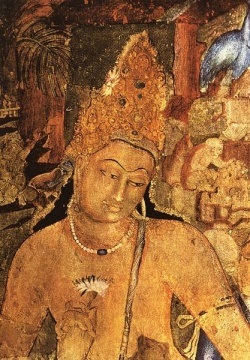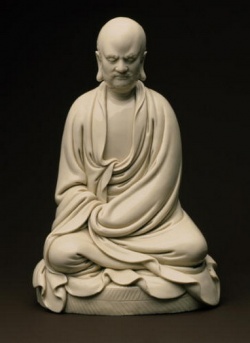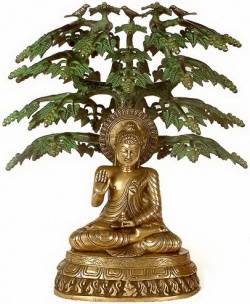Approaching the yanas
Asking One’s Teacher for Guidelines with regard to Practice:
Q: How does Dzogchen shi-nè—sitting—fit in if you are doing Tantra practice? I mean, can you do the two together?
R: Always. You will find shi-nè in every vehicle – Sutra, Tantra, Dzogchen.
Q: If your teacher gives you things to do—visualisations—do you also do a separate shi-nè?
R: You always need to ask your own teacher’s advice on anything you learn elsewhere; that is a general guideline. I will say to my students: ‘Study with anybody who comes along. If you see conflicts or have problems, ask me about it, so I can explain. If you receive practices, show them to me; and I will give you guidance on how to work with those practices.’ Whatever teacher you listen to, take that back to your own teacher and discuss it with him or her. The important thing about a Root Teacher, is that whatever practice you are given by any other teacher, you maintain your commitments by your commitment to your own Root Teacher. He or she guides your practice, gives you instruction, and shows you how to integrate whatever it is that you learned. That is important – it is important that one does not become too experimental with one’s practice, pulling in bits and pieces from here and there. Otherwise it makes it difficult to listen to other teachers.
Teachings Styles and Ngöndro:
Q: You said that the basis of Tantra would be Sutra – an understanding or experience of emptiness?
R: The basis of Tantra is emptiness.
Q: Then when you start practising Tantra you should have a basis of emptiness?
R: Yes.
Q: So that means that you have to develop that first, right, before you start doing Tantric practice?
R: Not necessarily – that can be confusing. Some teachers may say you must establish this ground of emptiness through silent sitting; and you must continue with this practice for sufficient years until you have that. That is one way of working – a powerful, valid way of working. Other teachers will introduce you directly into Tantra; they will make Tantra itself the practice of realising emptiness. It depends on many factors. As an answer for now, I would say it depends on the teacher. The teacher is an integral aspect of Tantra. There is no such thing as deciding that one is ready for Tantra. And yet, if one has a relationship with a teacher, one can be introduced before one is ready, according to certain perspectives. There are many different perspectives on what is required in order to be ready. Fundamentally it depends on relationship with the teacher. Theoretically, one requires the experience of emptiness in order to practise Tantra. But then, Tantra itself can be a preparation for the experience of emptiness – especially the relationship with the teacher; because there devotion equates to emptiness. It all depends how one is being introduced, and who is being introduced, and how that introduction is taking place. People practise with different teachers and in different traditions. Every tradition works in its own particular way, and has its own special value. There is always a principle to understand; and when one understands the principle and function of a practice, there is never any problem.
The understanding of the yanas is one of the main keys to non-sectarianism. If you understand the yanas, then you can see some practice, and you can ask yourself: ‘What is the principle and function here?’ Then you can see something of value for people. That is what is important – a quality of intelligence here, of being open and saying: ‘What is the value of this?’ Then you have little problem with the fact that there are differences in the world – that people do things in different ways. You see, these practices are not discreet entities; they are all about our condition and how to work with it. Contained within Tantra is everything you need; contained within Dzogchen is everything you need. It depends on the teacher, and what his or her style of presentation is. Some teachers approach from Dzogchen immediately; others from Tantra immediately; others from Sutra. Their style of teaching will be geared to a certain kind of individual; teachers attract students who have some propensity for understanding through their particular presentation. Now, if those students are not at the base, then teachers will give practices that are designed to allow the student to arrive at the base quickly. One such practice is called Tantric ngöndro – the hundred thousand prostrations, mandala offerings, Dorsem practice, and Lama’i Naljor. Many people have the idea that that this is what is meant by the word ‘ngöndro’; but there are different kinds of ngöndro. There is ngöndro for Dzogchen, ngöndro for Dzogchen to-gal – many styles of ngöndro.
There is psychotherapy – this is the ngöndro for Sutra; this is my unofficial statement on the subject, but this is how I would categorise it. Ngöndro is preparation – it is what brings you to the base. If psychotherapy enables you to be a functioning human being, who can go out and be a real mensch and live life and achieve goals, then you are going to get suspicious and be able to practise Sutra; so it functions as a ngöndro. Ngo means before, dro means going. Ngöndro means foundation, preparation. Preparation is required for everything. The preparation for defecation is that you remove certain items of clothing. If you neglect the ngöndro, then serious things happen; unless you are little Robert, and then that gets taken care of. Some teachers operate in that way. They take care of their students, who are probably small in number, by having a kind of diaper-principle. They say: ‘Go ahead without the preparation; and I will clean up the consequences for you.’ That can happen; but you need a small number of students for that particular kind of practice. Each ngöndro has the flavour of the practice for which it is the ngöndro. Tantric ngöndro looks like Tantra; but through this, you can realise emptiness. Prostrations are a practice of emptiness. You can find all the paramitas there – all Sutric practice is condensed into this ngöndro. The practice of refuge, bodhicitta, cultivation of patience, generosity – everything is within that Tantric ngöndro. The same applies to the ngöndro of Dzogchen, the Four Naljors – if you look at that ngöndro, it contains everything within Sutra and Tantra. It begins with shi-nè; which equates with Sutra. It ends with lhundrüp, which equates with the heart practice of Dzogchen, as Lama’i Naljor or Guru Yoga is the heart practice of Tantra. The ngöndro starts always with Sutra, moves quickly through the vehicle(s) and ends at the base. This is the principle of ngöndro.
Q: Ngöndro is a preparation. But it is also seen as a complete practice in itself? A sole practice for a lifetime?
R: Yes. That is because it ends with Lama’i Naljor, which is the heart of Tantric practice. That is really important. I think it is a problem, really, to look at any ngöndro as something to be ‘got over with’. That is difficult. The approach varies with each teacher, according to a style that equates with his or her mandala of students. You know this if you study with different teachers, and you have experience of what it is like being amongst their sangha. You say: ‘Oh! This is a different sangha. There is an energy here that is different – a style of language, a style of dress, an atmosphere. That is all a part of the teaching. Some people are relatively subdued, and other people can be quite boisterous; some are quite incisive, others are mellow. It all depends on how the teacher presents; and this equates with the teaching, too. Although people have no preparation, perhaps, for Tantra, because the teacher teaches from that perspective, he or she will bring all the students up to that level in whatever method.
The teacher expresses the teachings of the other vehicles through the language of whatever vehicle he or she is teaching. With the nine yanas there are theoretically eighty-one forms of expressing; because every vehicle has a language and can speak of the other vehicles in that language. One can speak of Sutra from the perspective of Dzogchen. This seemed highly characteristic, for example, of Trungpa Rinpoche; it gave the teaching of Sutra a particular dynamism. One can also speak of Tantra from the language of Dzogchen. One can speak of Tantra from the language of Sutra; this is a characteristic of the Gélug School. This is why, when Tantra is discussed, bodhicitta is given emphasis. Once you know about the yanas; you can listen to a teaching and say: ‘What is the principle here?’ In fact, if a teacher is emphasising principle and function, they probably are talking from the perspective of Dzogchen, in particular Dzogchen men-ngak-dé. This attention to principle and function is valuable in looking at any practice. It is important that one knows what one is doing; because the method, the compassionate nature of that spiritual enterprise, needs to be appreciated. One has to thoroughly feel its texture. Bodhicitta—in terms of compassion—is not such a principle in Tantra. Here we are dealing with ambivalence and with devotion. Devotion equates with emptiness; ambivalence equates with form. One talks about ‘vajra stupidity’, that which confounds emptiness and form – it cannot tell the difference between them. This is a particular style of Tantric language, that uses the language of negativity itself to describe the realised state. This type of language has a certain effect – you are using words that you would not otherwise use. It is powerful, for those who are open to that style of language. All the five kleshas get a ‘vajra’ added to them – vajra pride, vajra lust, vajra wrath.
Language and Yana
Kriyatantra
Every yana has its own language, its way of expression. One can divide Tantra into outer and inner Tantra. Outer Tantra is the path of relating to energy through purification. Here one is at the gun range; one has this dangerous object, and there are certain rules. You observe the rules precisely; because terrible things could happen if you did not. This is a dangerous area; one has to be scrupulous. That is the emphasis; nothing is left to chance. There is a sense almost of panic that is being instilled, that is actually valuable at one stage of practice. That is the principle and the kind of image that one is working with in Kriyatantra.
Q: Does that mean, Rinpoche, that the notion of defilements is seen as dangerous? So you get rid of defilements because they are so dangerous to your advancement as a practitioner?
R: Yes. This is why, in terms of Kriyatantra, one would never have a shrine in one’s bedroom. Or, if one had the shrine in one’s bedroom, one would have to have a curtain over it. Then at a later stage, there is the wonderful story of a student of Chatral Rinpoche who was in retreat; and there was a sponsor coming up to see him. He had been sitting there for a long time. There was dust and muck all over his shrine. He thought: ‘Oh dear, the sponsor is not going to like this much’; so he spent the day cleaning everything up nicely. Then he was looking at it, and he thought: ‘Oh! This is terrible hypocrisy’; so he got a pile of dust and threw it all over and continued to sit there. One would not do this in Kriyatantra – this would really be a bad thing to do! The story goes on that the sponsor came and saw all the dust and disarray; he was pleased and said: ‘Oh! You really are a great practitioner. You don’t really care.’ But then the story could have easily gone the other way. The person’s teacher could have gone there and said: ‘You slovenly swine!’ One can apply different criteria according to where the person is.
Q: How does merit fit into that? Gaining merit? You do this in order to gain merit and for purification? How does that fit in with Kriya?
R: That is much a part of Kriyatantra, because it is structured, and it is a bridge from Sutra.
The Yanas as Sequential and Non-sequential:
Q: Are the nine yanas a linear progression? Is it actually possible to tell where you are within the nine yanas? Or do you do this for a while, and then go back and work on purification some more?
R: It is both linear and non-linear; it is both sequential and non-sequential. One can approach it in a sequential way. There are many aspects of the teaching that are presented sequentially; but when it comes to practice your realise that it is not sequential – it is an organic situation. This is particularly true when one looks at Dzogchen and how it is practised; the perspective is that one has to be open to every level of teaching and observe one’s condition. ‘What is my condition at the moment?’
Motivation Defines One’s Practice:
The yanas are presented in a progressive manner of how one leads to another. Yet this is crucial about the yanas: It is not what you are practising that defines what you are practising – it is what your motivation is. If I practise Dzogchen with a motivation to accomplish my own realisation, I am not practising Dzogchen – I am practising Pratyékabuddhayana. I may be practising a Dzogchen method; but without the correct motivation, it is just a method. That is important for whoever does anything: It is not simply the method, but who does the method. I cannot divide myself from the method. If I am a schmuck, and I am practising Dzogchen, then I am a schmuck practising Dzogchen – that is what that means. Or I am a schmuck pretending to practise Dzogchen by acting out some kind of instructions – that is all it is.
Q: It really means you are not practising?
R: That is right. I am not practising. I have just got hold of some idea, and I am trying to do something with it. One has to understand how that evolves.
Dzogchen:
Let us look at Dzogchen. The basis of Dzogchen is the fruition of Tantra, which is the nondual state, the realised state. The path is that, when distracted from the realised state, one returns to the realised state. The fruit is the realised state; so base, path and fruit are all the same. One may ask: ‘How does one practise this?’ From a certain point of view, one would say: ‘Only a Buddha can practise this.’ From a certain point of view, one would say: ‘Well, that is what you are.’ Dzogchen contains a ngöndro, the ngöndro of Dzogchen sem-dé, which is the Four Naljors. What is crucial is that the actual methodology is the nature of compassion itself – that there is an approach from any angle. Whatever the base, there is always an approach. There is always something one can do; there is always a handle that one can get hold of somewhere according to one’s own perspective and one’s own condition.



